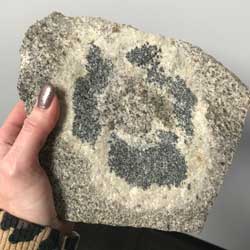The Geoscientist: Debra Shewfelt is a co-president and senior geologist at Respec Consulting in Saskatoon.
The rock: The Scrubber Granite of the Australian Outback.
Debra Shewfelt, P.Geo.
Why its important
Ask a geoscientist to choose their favourite rock or mineral and you’ll see that this is more difficult than asking them to choose their favourite childhood memory, their favourite beer or wine. So many choices, all good, all with their own amazing characteristics.
There’s an emotional attachment – a deep appreciation that borders on infatuation with our collections that only a true rockhound can appreciate. Choosing only one rock feels wrong.
At first, it seemed a difficult task, but then it dawned on me – is there really any choice other than the rock that I went halfway around the world to study? The perplexing texture that I examined at kilometre-scale field mapping down to the minutia of fluid inclusion bubbles and isotopic ratios?
The Scrubber Granite of the Australian Outback. This is not just any granite – no offense, common granite, but this is not the run-of-the-mill pink, black and white. This is an extraordinary granite, 1,800 million years in the making that shall never be rivalled in any rock collection.
The Scrubber Granite has an amazing texture that has been observed in select granitic outcrops worldwide: tourmaline nodules. These are nodules of various shapes, sizes and distribution; some perfectly spherical, some elongated, others doughnut shaped.
A characteristic halo occurs around the dense, nodule centre, contains black crystals that are long, bladed and fantastic.
While observed on many continents, a singular hypothesis for how these nodules formed has eluded geoscientists since their first documented encounter in the 1950s. Why do these granites have them, while most others do not? What conditions are necessary for their development and preservation? What does their formation tell us about magmatic processes in the earth? What can it tell us about the partitioning of rare, incompatible elements of interest, which are highly sought after for their use in modern electronics, clean energy, aerospace, and more?
Amazing samples of the Scrubber Granite tourmaline nodules, a marvel of the geoscience world, are displayed prominently in my home, outside in the rock garden and at work as polished slabs and as rough-edged outcrop samples (I highly recommend the experience of exploding an outcrop in the Outback).
This rock will always have a special place in my scientific brain and in my heart. It was my whole world for two-plus years as I completed a Master of Science in Geology at the University of Saskatchewan, a joint project with the Geological Survey of Western Australia. These tourmaline nodules will remain near and dear to me forever.

